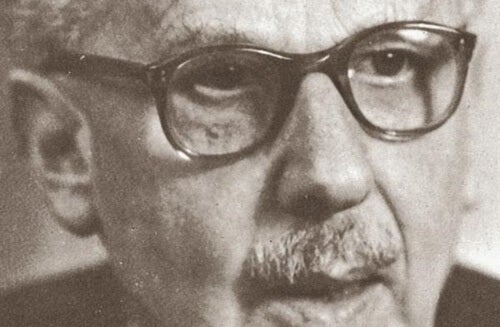Ludwig Binswanger: The Pioneer of Existential Psychology


Written and verified by the psychologist Valeria Sabater
Ludwig Binswanger was a Swiss psychiatrist and writer who introduced the term Daseinsanalyse (Daseinsanalysis) into the field of psychoanalysis. With this term, he referred to the fact that human beings were open to any experience. Therefore, the patient’s psyche isn’t an isolated entity or reduced to its own processes. An individual’s behavior is, in a way, defined by their environment and their interpretation of it.
Few figures in the psychoanalytic school were as close as Ludwig Binswanger and Sigmund Freud. Although they differed a lot at a theoretical level, they always admired each other. They sent letters to each other very often and even Freud himself offered Ludwig refuge during World War II. Both of them enriched the foundations of this therapeutic school.
Ludwig Binswanger was the first existentialist psychiatrist. The works of authors such as Edmund Husserl and Martin Heidegger greatly inspired him. This allowed him to approach every patient’s reality in a unique way. Moreover, he put aside that limited perspective that stated that a therapist would only focus on the individual’s pathological aspects. For the first time, therapies started focusing on the human being’s reality, circumstances, and context.
In 1956, he received the Kraepelin medal, the highest distinction in the field of psychiatry. At the time, he was admired by everyone around him. Artists, musicians, poets, writers, and philosophers such as Ortega y Gasset, Martin Buber, or Heidegger established a friendship with this key figure in the history of psychology.
Ludwig Binswanger, a figure with his own voice

Ludwig Binswanger was born in Kreuzlingen, Switzerland, in 1881. We certainly can’t ignore the relevance of this European city as the key to the birthplace of psychoanalysis. At the beginning of the 20th century, at the University of Zurich, it was possible to see gatherings between such emblematic figures as Carl Jung and Eugen Bleuler.
In fact, both of them were Binswanger’s colleagues. However, the one figure he’d always say marked his academic and professional life was, without a doubt, Sigmund Freud. Their friendship lasted a lifetime and was decisive, especially when Binswanger was diagnosed with a malignant tumor in 1912. Their bond gave him strength and determination during this tough time.
Once that trance was over, it wasn’t long before he joined the “Freud Group”, the theoretical nucleus that Carl Jung led in Switzerland. Now, we must note that, although he had a faithful friendship with and admired Sigmund Freud, Ludwig Binswanger had his own ideas about what clinical psychiatry should be about.
His individual perspective strayed a lot from classic psychoanalysis.
The pioneer of existential psychology
Ludwig Binswanger was the medical director of the Bellevue Hospital in his hometown of Kreuzlingen from 1911 to 1956. In fact, his grandfather founded this internationally renowned clinic. Moreover, Binswanger used this place to innovate on new therapeutic foundations. So much so that many people know him as the first doctor to combine psychotherapy with existential and phenomenological philosophy.
In 1942, he wrote the book Basic Forms and the Realization of Human “Being-in-the-World”. In this piece of work, he introduced the term Daseinsanalyse right off the bat and talked about making use of existential analysis as an empirical science. Its purpose was undoubtedly the most innovative in the psychoanalytic field. It’s based on the following premises:
- Applying an anthropological approach in order to understand the patient’s behavior.
- Making use of Husserl’s theory of the vital world to fully comprehend the subjective experiences of patients.
- Mental illness is, therefore, not an isolated entity. It doesn’t always respond to an individual and reduced process of the patient’s psyche. It’s also important to take into account the structural links that the patient establishes.
- To understand pathologies, it’s vital for many aspects to be studied. For example, the way in which individuals experience their reality and understanding how it makes them feel both physically and emotionally. In addition to this, it’s important to understand their social relationships.

The theoretical contributions of Ludwig Binswanger
Ludwig Binswanger was a pioneer in the creation of the existential psychology school. Thanks to him, it was possible to understand the complexities of human existence and the relevance that this had in the clinical field.
He wrote almost a hundred articles, books, reports, and methodological criticisms of psychoanalysis. One of the most popular ones is Die drei Grundelemente des wissenschaftlichen Denkens bei Freud (The Three Fundamental Elements of Freud’s Scientific Ideas; 1921).
He subjected psychoanalysis to improvement. He discarded the methodology that was being used and, instead, he introduced the foundations of Edmund Husserl’s phenomenology and Wilhelm Dilthey’s hermeneutics.
Binswanger’s unique perspective showed that every individual is free to build the type of existence they want. There’ll be those who want to dedicate their lives to art, others to the world of business, others will want to spend their lives helping others, etc. Existence transcends being and each subject is free to take the existential path they choose.
In turn, he defined three very specific types of existence:
- The Umwelt. The world around us. In other words, the relationship that all living beings have with their environment.
- The Mitwelt. The living being in relation to the world. In this case, Binswanger referred to the relationships individuals establish between themselves.
- The Eigenwelt. The individual world, making reference to each person’s subjective and personal experience.
Love can change you
Another very interesting concept by Ludwig Binswanger was Being-beyond-the-world. With this idea, the Swiss psychiatrist referred to the fact that it’s in every individual’s power to change the circumstances that make them uncomfortable and unhappy. Their free will makes this possible.
- Furthermore, according to Binswanger’s existential approach, one of the main characteristics of human beings is their ability to transcend, move forward, and transform. These changes can only come about through motivation and, without a doubt, love is one of the biggest motivating sources that exist.
- This dimension can lead anyone to a new and better reality. Giving and receiving love is always going to be important in life. It makes it possible to transform relationships and even the world itself.

The orientation of Binswanger’s train of thought, the so-called Daseinanalyse (or existential analysis) spread throughout Europe and the United States in a short time. To this day, his legacy remains one of the most interesting trends in contemporary psychology.
Ludwig Binswanger passed away in 1966 in his hometown of Kreuzlingen. He was 75 years old.
All cited sources were thoroughly reviewed by our team to ensure their quality, reliability, currency, and validity. The bibliography of this article was considered reliable and of academic or scientific accuracy.
- Hoffman, Klaus (2002) Historical essays on Ludwig Binswanger and psychoanalysis. Zeitschrift zur Geschichte der Psychoanalys
- Straus, E (1966) To the memory of Ludwig Binswanger. Der Nervenarzt
This text is provided for informational purposes only and does not replace consultation with a professional. If in doubt, consult your specialist.








